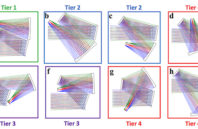Lenses and mirrors with freeform surfaces enable optical designers to create, for some purposes, optical devices that are lighter, more compact, and more effective than conventional designs using spherical or even rotationally symmetric aspherical optics.
However, until now, determining which freeform surfaces will work best (if at all) in a given optical configuration has been a time-consuming and often expensive process of trial and error.
Now, in a paper in Nature Communications, lead author Aaron Bauer, a senior research engineer at the University of Rochester’s Center for Freeform Optics (CeFO), combines theory and practice in a step-by-step method that eliminates much of the guesswork.
“Aaron has developed a process to design with freeform surfaces that can be applied very generally,” says coauthor Jannick Rolland, CeFO director and Brian F. Thompson Professor of Optical Engineering. “It’s really beautiful, and even at times feels like magic.”
She believes the findings will help accelerate the adoption of freeform optics in industry. “People will no longer say ‘Oh, it’s too expensive to build with freeform optics,'” she says. “Because now you can make something that may cost a tenth of what it would have cost otherwise.”

 (585) 768-2513
(585) 768-2513

